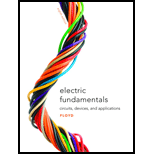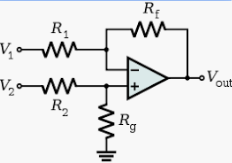
Electronics Fundamentals: Circuits, Devices & Applications
8th Edition
ISBN: 9780135072950
Author: Thomas L. Floyd, David Buchla
Publisher: Prentice Hall
expand_more
expand_more
format_list_bulleted
Concept explainers
Textbook Question
Chapter 18, Problem 1TFQ
When a diff-amp has identical signals on both inputs, the signals are referred to as differential signals.
Expert Solution & Answer
To determine
Whether the given statement is true or false.
Answer to Problem 1TFQ
The statement is false.
Explanation of Solution
Given:
The differential signals are known as the diff-amp that has the identical signals on the both inputs.
Calculation:
The circuit diagram for the differential amplifier is shown below:

When the diff-amp has identical signals on the both the inputs, the signal is referred as the common mode signals.
Therefore, the given statement is false that the differential amplifier having equal signals on both the inputs are referred as the differential signals.
Want to see more full solutions like this?
Subscribe now to access step-by-step solutions to millions of textbook problems written by subject matter experts!
Students have asked these similar questions
+
V 6.2 A
1.2 A
S
R
4 Ω
Find the source voltage Vs
0.8 A
Determine i(t) for t≥ 0 given that the circuit below had
been in steady state for a long time prior to t = 0. Also, I₁ =
1
5 A, R₁ =22, R2 =10 Q2, R3 = 32, R4 =7 2, and L=0.15 H.
Also fill the table.
m
L
ww
R2
t = 0
R₁
29
R3
R4
Time
0
iL(t)
0
8
Please help explain this problem
Chapter 18 Solutions
Electronics Fundamentals: Circuits, Devices & Applications
Ch. 18 - When a diff-amp has identical signals on both...Ch. 18 - A high CMRR for a diff-amp means the common-mode...Ch. 18 - Prob. 3TFQCh. 18 - The open-loop voltage gain of an op-amp is also...Ch. 18 - Prob. 5TFQCh. 18 - Prob. 6TFQCh. 18 - In a voltage-follower, the open-loop and...Ch. 18 - Prob. 8TFQCh. 18 - Prob. 9TFQCh. 18 - If the feedback resistor in an amplifier is open,...
Ch. 18 - Which characteristic docs not necessarily apply to...Ch. 18 - In selecting an op-amp. suppose you have several...Ch. 18 - Prob. 3STCh. 18 - Prob. 4STCh. 18 - Prob. 5STCh. 18 - Prob. 6STCh. 18 - Prob. 7STCh. 18 - Prob. 8STCh. 18 - If you know an op-amp's open-loop gain and nothing...Ch. 18 - Prob. 10STCh. 18 - Prob. 11STCh. 18 - The highest possible input resistance is achieved...Ch. 18 - Compare a practical op-amp to an ideal op-amp.Ch. 18 - Two IC op-amps are available to you. Their...Ch. 18 - Identify the type of input and output...Ch. 18 - Prob. 4PCh. 18 - A certain diff-amp has a differential gain of 60...Ch. 18 - A certain diff-amp has a CMRR of 65 dB. If the...Ch. 18 - Identify the type of input mode for each op-amp in...Ch. 18 - Show the common-mode input in Figure 18-37 in an...Ch. 18 - Determine the bias current, IBIAS, given that the...Ch. 18 - Distinguish between input bias current and input...Ch. 18 - A certain op-amp has a CMRR of 250,000. Convert...Ch. 18 - The open-loop gain of a certain op-amp is 175,000....Ch. 18 - The op-amp data sheet specifies a CMRR of 300,000...Ch. 18 - Figure 18-38 shows the output voltage of an op-amp...Ch. 18 - How long does it take the output voltage of an...Ch. 18 - Identify each of the op-amp configurations in...Ch. 18 - For the amplifier in Figure 18-40. determine the...Ch. 18 - Determine the closed-loop gain of each amplifier...Ch. 18 - Find the value of Rf that will produce the...Ch. 18 - Find the gain of each in amplifier in Figure...Ch. 18 - If a signal voltage of 10 mV applied to each...Ch. 18 - Determine the approximate values for each of the...Ch. 18 - Determine the input and output resistances for...Ch. 18 - Repeat Problem 23 for each circuit in Figure...Ch. 18 - Repeat Problem 23 for each circuit in Figure...Ch. 18 - Prob. 26PCh. 18 - Prob. 28PCh. 18 - Prob. 29PCh. 18 - Prob. 30PCh. 18 - Prob. 31PCh. 18 - Prob. 32P
Knowledge Booster
Learn more about
Need a deep-dive on the concept behind this application? Look no further. Learn more about this topic, electrical-engineering and related others by exploring similar questions and additional content below.Similar questions
- + P = 16 W w w P = 8 W I R₁ R2 E = RT=322 1- Determine R1, R2, E ΙΩarrow_forward+ 30 V = - 20 V + R 2- Use KVL to find the voltage V - V + + 8 Varrow_forwardFind the Thévenin equivalent circuit for the portions of the networks in Figure external to the elements between points a and b. a R₁ 2002 I = 0.1 A 0° Xc : 32 Ω R2 = 6802 20 Ω фъarrow_forward
- Find the Norton equivalent circuit for the network external to the elements between a and b for the networks in Figure. E1 = 120 V Z 0° R ww 10 Ω Xc XL · 000 802 802 ① I = 0.5 AZ 60° ZL barrow_forwardUsing superposition, determine the current through inductance XL for each network in Figure I = 0.3 A 60° XL 000 802 XC 502 Ω E 10 V0° =arrow_forwardFind the Thévenin equivalent circuit for the portions of the networks in Figure external to the elements between points a and b. E = 20 VZ0° + R ww 2 ΚΩ Хо XL 000 6ΚΩ 3 ΚΩ b RLarrow_forward
- What percentage of the full-load current of a thermally protected continuous-duty motor of more than one Hp can the trip current be, if the full-load current is 15 amperes? Ο 122 Ο 140 156 O 170arrow_forwardQ3arrow_forwardIn thinkercad can you make a parallel series circuit with a resistors and a voltage source explain how the voltage and current moves through the circuit, and explaining all the components, and if you were to break the circuit to find the current how would you do that? Please show visuals if possible.arrow_forward
- In thinkercad can you make a series circuit with a resistors and a voltage source explain how the voltage and current moves through the circuit, and explaining all the components, and if you were to break the circuit to find the current how would you do that? Please show visuals if possible.arrow_forwardIn thinkercad can you make a parallel circuit with a resistors and a voltage source explain how the voltage and current moves through the circuit, and explaining all the components, and if you were to break the circuit to find the current how would you do that? Please show visuals if possiblearrow_forwardQ1arrow_forward
arrow_back_ios
SEE MORE QUESTIONS
arrow_forward_ios
Recommended textbooks for you
 Introductory Circuit Analysis (13th Edition)Electrical EngineeringISBN:9780133923605Author:Robert L. BoylestadPublisher:PEARSON
Introductory Circuit Analysis (13th Edition)Electrical EngineeringISBN:9780133923605Author:Robert L. BoylestadPublisher:PEARSON Delmar's Standard Textbook Of ElectricityElectrical EngineeringISBN:9781337900348Author:Stephen L. HermanPublisher:Cengage Learning
Delmar's Standard Textbook Of ElectricityElectrical EngineeringISBN:9781337900348Author:Stephen L. HermanPublisher:Cengage Learning Programmable Logic ControllersElectrical EngineeringISBN:9780073373843Author:Frank D. PetruzellaPublisher:McGraw-Hill Education
Programmable Logic ControllersElectrical EngineeringISBN:9780073373843Author:Frank D. PetruzellaPublisher:McGraw-Hill Education Fundamentals of Electric CircuitsElectrical EngineeringISBN:9780078028229Author:Charles K Alexander, Matthew SadikuPublisher:McGraw-Hill Education
Fundamentals of Electric CircuitsElectrical EngineeringISBN:9780078028229Author:Charles K Alexander, Matthew SadikuPublisher:McGraw-Hill Education Electric Circuits. (11th Edition)Electrical EngineeringISBN:9780134746968Author:James W. Nilsson, Susan RiedelPublisher:PEARSON
Electric Circuits. (11th Edition)Electrical EngineeringISBN:9780134746968Author:James W. Nilsson, Susan RiedelPublisher:PEARSON Engineering ElectromagneticsElectrical EngineeringISBN:9780078028151Author:Hayt, William H. (william Hart), Jr, BUCK, John A.Publisher:Mcgraw-hill Education,
Engineering ElectromagneticsElectrical EngineeringISBN:9780078028151Author:Hayt, William H. (william Hart), Jr, BUCK, John A.Publisher:Mcgraw-hill Education,

Introductory Circuit Analysis (13th Edition)
Electrical Engineering
ISBN:9780133923605
Author:Robert L. Boylestad
Publisher:PEARSON

Delmar's Standard Textbook Of Electricity
Electrical Engineering
ISBN:9781337900348
Author:Stephen L. Herman
Publisher:Cengage Learning

Programmable Logic Controllers
Electrical Engineering
ISBN:9780073373843
Author:Frank D. Petruzella
Publisher:McGraw-Hill Education

Fundamentals of Electric Circuits
Electrical Engineering
ISBN:9780078028229
Author:Charles K Alexander, Matthew Sadiku
Publisher:McGraw-Hill Education

Electric Circuits. (11th Edition)
Electrical Engineering
ISBN:9780134746968
Author:James W. Nilsson, Susan Riedel
Publisher:PEARSON

Engineering Electromagnetics
Electrical Engineering
ISBN:9780078028151
Author:Hayt, William H. (william Hart), Jr, BUCK, John A.
Publisher:Mcgraw-hill Education,
What is a Power Amplifier, And Do I Need One?; Author: Sweetwater;https://www.youtube.com/watch?v=2wkmSm4V00M;License: Standard Youtube License